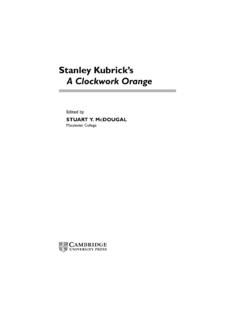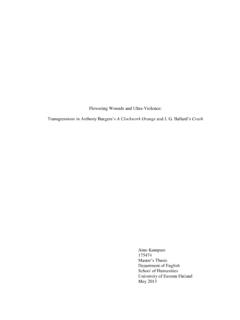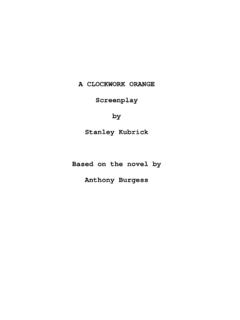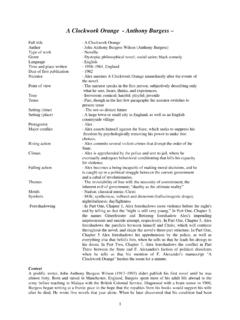Transcription of DARKER THAN ANY PRISON, HOTTER THAN ANY HUMAN FLAME ...
1 " DARKER THAN ANY PRISON, HOTTERTHAN ANY HUMAN FLAME ": PUNISHMENT,CHOICE, AND CULPABILITY INA clockwork ORANGEILLYA LICHTENBERGM ontciair State UniversityHOWAKD LUNEW illiam Faterson UniversityPATRICK MCMANIMON, UniversityContemporary textbooks in criminal justice use a clockwork orange to illustrateissues of correction^ and sentencing practices. This article challenges criminal jus-tice faculty and students to use the film to explore the political and social realities ofpunishment, in particular the examination of the moral question of "voluntariness"and the implications for "treatment" as a mechanism of social control.
2 This paperexplores the moral questions of state sponsored social control and using the filmsatire invites the student to examine their beliefs about the political and social reali-ties of punishment and use of films in teaching criminal justice is far from a new peda-gogic practice. Recent technological advances and increasing accessibilityto varied forms of media and media devices has made the use of videotechnology in tbe classroom simple and prevalent. Less prevalent in crimi-nal justice are guides and research on the utility of films in criminal justice has fallen behind other fields in examining the use offilm as a pedagogic tool.
3 Psychology in particular bas closely examined thepotential benefits of films for classroom teaching (Paddock, Terranova, &Giles 200].; Bluestone 2000; Hudock & Warden 2001; Downey, Jackson, &Furman 2001). There have also been some empirical tests of the effective-ness of films as a pedagogic tool, which have been positive, though morethorough empirical testing would be helpful (Roskos-Ewoldsen & Roskos-Ewoldsen 2001). In addition, research has started focusing beyond the useof full-length feature films to include testing the use of short clips that onlyoccupy a segment of a full class.
4 (Roskos-Ewoldsen & Roskos-Ewoldsen2001).JOURNAL OF CRIMINAL JUSTICE EDUCATION, Vol. 15 No. 2, Fall 2004 2004 Academy of Criminal Justice Sciences430 " DARKER THAN ANY PRISON, HOTTER THAN ANY HUMAN FLAME "This article explores the movie a clockwork orange (1971) as a full-length film presented to a classroom audience for the purpose of teaching abroader understanding of many important aspects of criminal justice andthe criminal justice system. This film is particularly beneficial in the area ofcorrections and sentencing, but also fits nicely with an introductory courseor a course on ethics or philosophical issues in punishment and humanrights.
5 This article does not subject the film to empirical scrutiny, butrather provides instructors with an analysis of a film that goes far beyondsimple practical benefit and reaches into some very controversial areas ofphilosophical and theoretical importance to criminal justice. It is also in-tended to stimulate discussion and empirical research into the effectivenessof film in teaching criminal justice and to encourage academics in criminaljustice to develop and improve upon the use of film as a pedagogic clockwork ORANGEThe Stanley Kubrick film a clockwork orange (1971), an adapted ver-sion of Anthony Burgess' (1963) work of the same title, has entertainedaudiences around the world for 40 years.
6 A biting satire, the film's valueextends beyond mere entertainment. Like the novel, the film version servesas a social indictment of the state and the use of modern techniques ofsocial control for political purposes, among a host of other topics implicat-ing the criminal justice system. Unlike many police dramas, A ClockworkOrange is deeply concerned with questions pertaining to the philosophy ofcorrections, as evidenced in part by the fact that textbooks in criminal jus-tice have used the film to illustrate matters of corrections and sentencing(Adler, Mueller, & Laufer 1994: 459).
7 The film impresses upon the viewerissues concerning the relationships and responsibilities between the indi-vidual and the state, criminal law, sentencing, punishment, corrections, andhuman culpability and vulnerability and the moral issues the film as a springboard, this article explores deep-seated moraldilemmas concerning punishment and the state. A clockwork Orangeserves as a venue and a pedagogic tool for stimulating class discussion andreaching further into this political satire's deeply rooted critique of this article is written with the hope that students (and faculty)
8 Enjoy the movie, and that the use of film assists in the students' compre-hension of the moral questions with which they are confronted, it is pre-mised upon the assumption that the moral dilemmas depicted in thefictional story are intended to be viewed as a commentary on problemsexisting within the modern criminal justice system. In particular, we ad-dress the concept of voluntariness and the implications for "choosing" toparticipate in various treatment modalities as they are or might be intro-duced within a criminal control system.
9 a clockwork orange questionsLICHTENBERG, LUNE, AND MCMANIMON, JR. 431whether any non-punitive "treatment" can be validly applied within thecontext of a coercive HISTORICAL ORIGINS AND SOCIALCONTEXT OF THE FILMIn the early 1960s, Lady Wootton (1960 as cited in Hart 1968) intro-duced critiques of the current modes of punishment in light of the alterna-tive models that had become popular in Great Britain. In a very simplifiedaccount. Lady Wootton proposed abolishing the concept of mens rea, thelegal requirement of a "criminal mind" or "criminal intent," as a require-ment for adjudicating the guilt of the accused.
10 Her essential argument was,since it is impossible to ever know the thought process and motive of anindividual when they commit an offense, the law can never be sure whatthe actor's true intentions and hence, moral culpability, were. Her pro-posed replacement for the mens rea requirement was to require offendersto be either punished or treated depending upon the nature of the approach would by-pass the question of offender guilt and culpability,whether the act was blameworthy, willful, accidental, or the product ofsome mental abnormality, and simply address need.



















